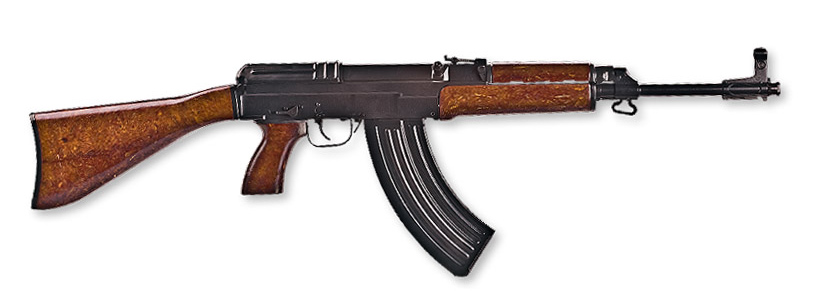

The failure of successive Liberal and Conservative governments to update a decades-old list of banned guns “poses a risk to public safety,” says a memo prepared for Public Safety Minister Vic Toews in January 2012.
The federal government has no plans to heed this advice – even after a gun police suggested prohibiting in 2010 was used in a fatal shooting at the Parti Quebécois election night victory party last year.
“The absence of regularly updating the regulations has allowed firearms to enter the Canadian market as non-restricted firearms that would have been classified as either restricted or prohibited had they existed in 1995,” reads the document, prepared by Public Safety officials for Toews last year.

Canadian law categorizes guns as restricted, non-restricted or prohibited based on characteristics such as barrel length; in the past it banned some, like the AK-47 assault rifle, by name. The list of banned weapons hasn’t been updated since 1995.
Watch: Ecole Polytechnique survivor Heidi Rathjen on gun control in Canada
This memo, released in redacted form as part of a larger access-to-information request, puts in plain terms something a Global News investigation revealed earlier this year: Failing to keep up with a changing arms industry leads to a bewildering and inconsistent set of loopholes in federal gun law.
“There are no plans to broadly reclassify firearms and there are no plans to alter the process in which firearms are classified,” Toews’ spokesperson Julie Carmichael said in an email.
“The regulations, as they are written, will not allow newly designed firearms that should be restricted or prohibited to be classified as non restricted.”
A spokesperson for Public Safety Canada said the document is a draft briefing note prepared for Toews by ministry staff in January 2012. The spokesperson refused to provide the final version.
(In a separate release of the same documents requested under access-to-information law in September 2012, the warning has been censored out. The censor cites sections of the Access to Information Act restricting material that constitutes advice for the government or could “reasonably be expected to facilitate the commission of an offence.”)
An RCMP presentation prepared in May 2010, also classified as secret, named firearms the RCMP felt should be more restricted or banned.

Included on the list is the family of Czech-made VZ58 assault rifles. At the time a Manitoba company had requested approval to import the semi-automatic CZ858, which externally resembles the banned AK-47. “A case could be made that they should be classified as prohibited,” the RCMP document reads.
The report also suggested banning Saskatchewan-made semi-automatic copies of the Second World War Sten sub-machine gun. 15 of these were registered as non-restricted firearms before the registry was destroyed last fall.
A CZ858 was used in the fatal shooting at the Parti Québécois victory party on Sept. 4, 2012. Richard Henry Bain, 62, faces over a dozen charges, including first-degree murder, in connection to the incident.
7,473 CZ858s are privately owned across Canada, largely in B.C. and Alberta, according to Global News’s copy of the firearms registry. 94% of those are non-restricted – the same category as mainstream shotguns and rifles used by farmers and hunters.
Based on current retail values, if the government wanted to reclassify those weapons it would cost $5.9-million to buy them back from their owners. (Earlier this year, federal officials budgeted $260,000 to buy back rifles that turned out to be easy to convert to automatic fire.)
“It’s a lot cheaper to restrict a weapon in advance than it is to buy it back after it’s been determined, too late, that it’s dangerous,” says Michael Bryant, former Ontario Attorney-General and spokesperson for the Coalition for Gun Control. “It turns out that the (long gun) registry was cheaper than this approach, by a long run.”
Toews wouldn’t speak to specific cases but told Global News “we constantly review these lists and consult with various groups.”
“All I can say is that these matters are reviewed regularly by my officials and they make the decisions that come to me for approval or disapproval.”
Liberal public safety critic Francis Scarpaleggia argues banning these weapons should be a matter of political will – even if it means angering a conservative base.
“The industry moves on, and it’s important that the government is staying on top of it,” he said.
“It all comes down to whether you have the will to proactively pursue this, and I don’t think the government does.”
But, Bryant argues, the federal Liberals – who didn’t add to the prohibited firearms list for most of their last decade in power – share responsibility for the outdated classifications.
“After the gun registry went through … the Liberals retreated from their position on gun control because of insecurity expressed by caucus members about the issue in rural ridings.”
Blair Hagen of the National Firearms Association takes a different view: He sees the document as part of an RCMP plan to curb semi-automatic rifles in general.
“They’ve been doing this incrementally for several years now, with firearms where there were low numbers actually imported into Canada, low numbers on the registry, and the reclassification itself might not create a political situation, or a legal situation, that would be a problem for the government.”
Destroying the long gun registry has made new bans very difficult, says Doug Carlson, a retired OPP staff sergeant who worked for years as a regional firearms officer in Ontario: It’s hard to make something illegal and get it off the street if you don’t know who has it.
“What happens if, for some reason, a currently classified non-restricted firearm is reclassified as prohibited? There won’t be any records of who owns the firearms other than in Quebec.”
With a report from Crystal Goomansingh in Winnipeg




Comments